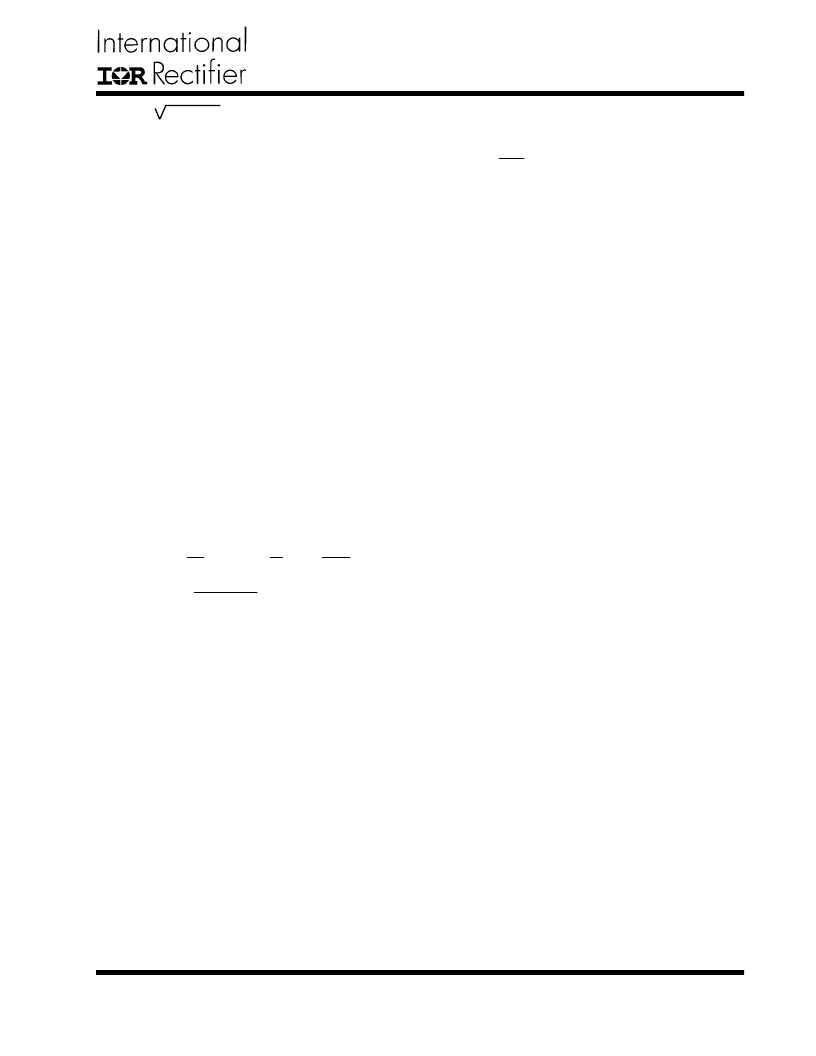- 您現(xiàn)在的位置:買賣IC網(wǎng) > PDF目錄377500 > IR3637SPBF (International Rectifier) 1% ACCURATE SYNCHRONOUS PWM CONTROLLER PDF資料下載
參數(shù)資料
| 型號: | IR3637SPBF |
| 廠商: | International Rectifier |
| 英文描述: | 1% ACCURATE SYNCHRONOUS PWM CONTROLLER |
| 中文描述: | 1%準確的同步PWM控制器 |
| 文件頁數(shù): | 7/21頁 |
| 文件大小: | 655K |
| 代理商: | IR3637SPBF |

IR3637SPBF
7
Rev. 1.1
06/16/05
www.irf.com
For higher efficiency, low ESR capacitor is recommended.
Two capacitors of Sanyo's TPB series PosCap with
150
μ
F, 6.3V, 40m
ESR and 1.4A ripple current will
meet the ripple current requirement.
Inductor Selection
The inductor is selected based on output power, operat-
ing frequency and efficiency requirements. Low inductor
value causes large ripple current, resulting in the smaller
size, faster response to a load transient but poor effi-
ciency and high output noise. Generally, the selection of
inductor value can be reduced to desired maximum ripple
current in the inductor (
i). The optimum point is usually
found between 20% and 50% ripple of the output cur-
rent.
For the buck converter, the inductor value for desired
operating ripple current can be determined using the fol-
lowing relation:
The ESR of the output capacitor is calculated by the
following relationship:
The Sanyo TPB series, PosCap capacitor is a good
choice. The 6TPB150M 150
μ
F, 6.3V has an ESR 40m
.
Selecting two of these capacitors in parallel, results to
an ESR of
20m
which achieves our low ESR goal.
Power MOSFET Selection
The IR3637 uses two N-Channel MOSFETs. The selec-
tions criteria to meet power transfer requirements is
based on maximum drain-source voltage (V
DSS
), gate-
source drive voltage (V
GS
), maximum output current, On-
resistance R
DS(on)
and thermal management.
The MOSFET must have a maximum operating voltage
(V
DSS
) exceeding the maximum input voltage (V
IN
).
The gate drive requirement is almost the same for both
MOSFETs. Logic-level transistor can be used and cau-
tion should be taken with devices at very low V
GS
to pre-
vent undesired turn-on of the complementary MOSFET,
which results a shoot-through current.
The total power dissipation for MOSFETs includes con-
duction and switching losses. For the Buck converter
the average inductor current is equal to the DC load cur-
rent. The conduction loss is defined as:
The R
DS(ON)
temperature dependency should be consid-
ered for the worst case operation. This is typically given
in the MOSFET data sheet. Ensure that the conduction
losses and switching losses do not exceed the package
ratings or violate the overall thermal budget.
Where:
V
IN
= Maximum Input Voltage
V
OUT
= Output Voltage
i = Inductor Ripple Current
f
S
= Switching Frequency
t = Turn On Time
D = Duty Cycle
V
IN
- V
OUT
= L
×
i
t = D
×
; D =
t
1
f
S
V
OUT
V
IN
L = (V
IN
- V
OUT
)
×
V
V
×
i
×
f
S
OUT
For I
OUT
=6A and D=0.36, the I
RMS
=2.8A
I
RMS
= I
OUT
D
×
(1-D)
---(3)
Where:
D is the Duty Cycle, D=V
OUT
/V
IN.
I
RMS
is the RMS value of the input capacitor current.
I
OUT
is the output current for each channel.
If
i = 40%(I
O
), then the output inductor will be:
L = 1.2
μ
H
The Coilcraft DO3316 series provides a range of induc-
tors in different values, low profile suitable for large cur-
rents, 1.5
μ
H, 8A(Isat) is a good choice for this applica-
tion.
Output Capacitor Selection
The criteria to select the output capacitor is normally
based on the value of the Effective Series Resistance
(ESR). In general, the output capacitor must have low
enough ESR to meet output ripple and load transient
requirements, yet have high enough ESR to satisfy sta-
bility requirements.
Where:
V
O
= Output Voltage Ripple
I
O
= Inductor Ripple Current
V
O
=50mV and
I
O
=2.4A
Results to ESR=20.8m
ESR
≤
---(4)
I
O
V
O
P
COND
(Upper Switch) = I
2
×
R
DS(on)
×
D
×
P
COND
(Lower Switch) = I
2
×
R
DS(on)
×
(1 - D)
×
= R
DS(ON)
Temperature Dependency
相關PDF資料 |
PDF描述 |
|---|---|
| IR3638SPBF | HIGH FREQUENCY SYNCHRONOUS PWM BUCK CONTROLLER FOR TRACKING APPLIACTIONS |
| IR3651SPBF | HIGH VOLTAGE SYNCHRONOUS PWM BUCK CONTROLLER |
| IR3651STRPBF | HIGH VOLTAGE SYNCHRONOUS PWM BUCK CONTROLLER |
| IR3811MPBF | HIGHLY INTEGRATED 7A WIDE-INPUT VOLTAGE, SYNCHRONOUS BUCK REGULATOR |
| IR3820AMPBF | HIGHLY INTEGRATED 14A WIDE-INPUT VOLTAGE, SYNCHRONOUS BUCK REGULATOR |
相關代理商/技術參數(shù) |
參數(shù)描述 |
|---|---|
| IR3637STRPBF | 功能描述:開關變換器、穩(wěn)壓器與控制器 2 CH OR 2 PHASE SYNC PWM CNTRLR RoHS:否 制造商:Texas Instruments 輸出電壓:1.2 V to 10 V 輸出電流:300 mA 輸出功率: 輸入電壓:3 V to 17 V 開關頻率:1 MHz 工作溫度范圍: 安裝風格:SMD/SMT 封裝 / 箱體:WSON-8 封裝:Reel |
| IR3638 | 制造商:ONSEMI 制造商全稱:ON Semiconductor 功能描述:High Frequency Synchronous |
| IR3638DR2G | 制造商:ON Semiconductor 功能描述: |
| IR3638SPBF | 制造商:IRF 制造商全稱:International Rectifier 功能描述:HIGH FREQUENCY SYNCHRONOUS PWM BUCK CONTROLLER FOR TRACKING APPLIACTIONS |
| IR3638STRPBF | 功能描述:電壓模式 PWM 控制器 HI FREQ SYNC PWM 400kHz 0.6V Track RoHS:否 制造商:Texas Instruments 輸出端數(shù)量:1 拓撲結構:Buck 輸出電壓:34 V 輸出電流: 開關頻率: 工作電源電壓:4.5 V to 5.5 V 電源電流:600 uA 最大工作溫度:+ 125 C 最小工作溫度:- 40 C 封裝 / 箱體:WSON-8 封裝:Reel |
發(fā)布緊急采購,3分鐘左右您將得到回復。